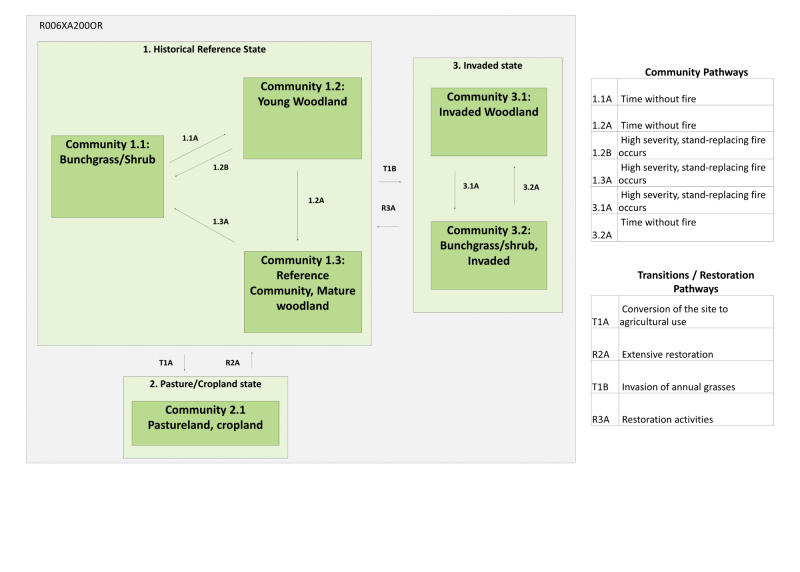
Natural Resources
Conservation Service
Ecological site R006XA200OR
South Slopes 14-20 PZ
Last updated: 3/31/2025
Accessed: 12/19/2025
General information
Provisional. A provisional ecological site description has undergone quality control and quality assurance review. It contains a working state and transition model and enough information to identify the ecological site.
MLRA notes
Major Land Resource Area (MLRA): 006X–Cascade Mountains, Eastern Slope
Stretching from northern Washington to southern Oregon, MLRA6 encompasses the mountain slopes, foothills, elevated plateaus and valleys on the eastern slopes of the Cascade mountains. This MLRA is a transitional area between the Cascade Mountains to the west and the lower lying Columbia Basalt Plateau to the east. Situated in the rain shadow of the Cascade Crest, this MLRA receives less precipitation than portions of the cascades further west and greater precipitation than the basalt plateaus to the east. Geologically, the majority of the MLRA is dominated by Miocene volcanic rocks, while the northern portion is dominated by Pre-Cretaceous metamorphic rocks and the southern portion is blanketed with a thick mantle of ash and pumice from Mount Mazama. The soils in the MLRA dominantly have a mesic, frigid, or cryic soil temperature regime, a xeric soil moisture regime, and mixed or glassy mineralogy. They generally are moderately deep to very deep, well drained, and loamy or ashy. Biologically, the MLRA is dominated by coniferous forest, large expanses of which are dominated by ponderosa pine, Douglas-fir or lodgepole pine. Areas experiencing cooler and moister conditions include grand fir, white fir, and western larch while the highest elevations include pacific silver fir, subalpine fir and whitebark pine. Economically, timber harvest and recreation are important land uses in these forests. Historically, many of these forests would have experienced relatively frequent, low and mixed severity fire favoring the development of mature forests dominated by ponderosa pine or Douglas-fir. In the southern pumice plateau forests, less frequent, higher severity fire was common and promoted the growth of large expanses of lodgepole pine forests.
LRU notes
Located at the eastern edge of the Columbia river gorge, this unit is restricted to areas influenced by the modified maritime climate of this unique passageway through the Cascades. This setting allows for the persistence of Oregon White Oak woodlands east of the Cascade crest. These woodlands often include ponderosa pine, and on sites with greater soil moisture, Douglas-fir. Botanical diversity is high, with a mixture of West Cascade and East Cascade plant species commonly co-occurring. Physiographically, this unit is characterized by dissected foothills, valleys and ridges draining Mount Hood in Oregon and Mount Adams in Washington. Geologically, the unit is characterized by late tertiary pyroclastic and volcanoclastic deposits and basalt flows. The climate of this unit is generally warm and dry with a predominately xeric soil moisture regime and mesic soil temperature regime. Historically, the drier extent of these forests have been influenced by a fire regime whereby frequent low and mixed severity fires would have favored the development of open canopied forests. Higher elevations and more westerly locations receiving more moisture within this unit would have been influenced by moderately frequent, low and mixed severity fires favoring a mosaic of forest stages with closed canopy conditions common.
Ecological site concept
This site represents a dry woodland community at the transition zone between the foothills on the eastside of the Oregon cascades and the Columbia plateau. The Reference Plant community is that of an Oregon white oak (Quercus garryana) woodland with an understory of perennial native grasses such as Sandberg bluegrass (Poa secunda) and bluebunch wheatgrass (Pseudoroegneria spicata) and shrubs such as antelope bitterbrush (Purshia tridentata) and green rabbitbrush (Chrysothamnus viscidiflorus). East cascade foothill plant communities are moisture limited and therefore highly influenced by aspect. This site occupies south slopes at the lower end of the precipitation range for Oregon white oak (14 to 20 in). Increased evapotranspiration as a result of south aspects create conditions favorable for white oak dominance on this site. This is in contrast to adjacent sites with more gentle slopes and higher precipitation (20 to 40 in) which favor competition by conifers and therefore support higher density of ponderosa pine (Pinus ponderosa) and Douglas-fir (Pseudotsuga menziesii) in the stand. Sites on north aspects often retain higher soil moisture and therefore exhibit higher productivity and higher cover of Idaho fescue (Festuca idahoensis).
This is a provisional ecological site and is subject to extensive review and revision before final approval. All data herein should be considered provisional and contingent upon field validation prior to use in conservation planning.
Associated sites
| R006XA300OR |
Loamy 14-20 PZ non-aspect positions, higher effective precipitation |
|---|
Similar sites
| R006XA300OR |
Loamy 14-20 PZ Non aspect, ponderosa pine common |
|---|---|
| R006XA302OR |
Steep South Slopes 20-40 PZ higher effective precipitation |
Table 1. Dominant plant species
| Tree |
(1) Quercus garryana |
|---|---|
| Shrub |
Not specified |
| Herbaceous |
(1) Pseudoroegneria spicata |
Click on box and path labels to scroll to the respective text.
Ecosystem states
| T1A | - | Conversion of the site to agricultural use. |
|---|---|---|
| T2A | - | Invasion of annual grasses |
| R2A | - | Extensive restoration |
| R3A | - | Restoration activities |
State 1 submodel, plant communities
| 1.1A | - | Time without fire |
|---|---|---|
| 1.2B | - | High severity, stand replacing fire occurs |
| 1.2A | - | Time without fire |
| 1.3A | - | High severity, stand replacing fire occurs |
State 3 submodel, plant communities
| 3.1A | - | High severity, stand replacing fire occurs |
|---|---|---|
| 3.1B | - | Time without fire |
